The indoor tropical plant aglaonema propagation, often known as Chinese evergreen, is excellent. The leaves of this plant are unquestionably its most fascinating feature. Depending on the variety, they are smooth green, red, speckled, silver, or any color. In addition to their leaves, they can produce small, unassuming flowers in the summer.
Aglaonema plants are multiplied by stem cuttings, using seeds, cuttings from roots, water, and tissue culture. These common houseplants are typically found in homes all across the world. The Chinese evergreen, or Aglaonema, is renowned for its strength and adaptability to any environment.
I’ll explain to you how to propagate Aglaonema in this blog post. Continue to listen to learn more!
Quick Navigation
The Methods For The Successful Propagation Of Aglaonema
In this section, I’ll explain five different propagation processes of Aglaonema plants.
Propagation Of Aglaonema Using Stem Cuttings
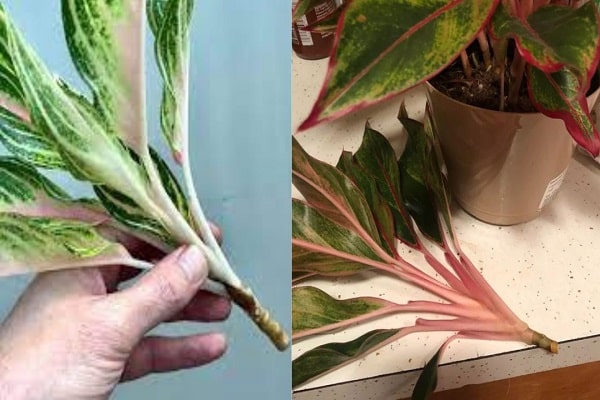
Stem cuttings are the easiest, safest, and simplest way for a beginner to start growing Aglaonema plants(Chinese evergreens).
- Use fresh shoots, and try to take cuttings around the middle of summer.
- Find one or two healthy side shoots on the mother plant to use as your cutting’s source. You’ll need at least 6 inches of healthy, well-grown shoots.
- Although older shoots can also be used, it is easier to root the younger ones.
- Use a clean, sharp knife or a small pair of pruning shears to cut the stem diagonally just below a leaf node.
- Next, take the leaves off the bottom of the plant, dip the cut end of the stem in rooting hormone powder, and then plant the stem in the container.
- Put some room-temperature distilled water in a small container. Wet the soil after you’ve filled the container with a potting soil mixture that drains properly.
- Create a small, deep hole, and then “place” your cutting into it. Then, gently pat the moist dirt around the cutting to ensure the stem is secure.
- Locate a site with bright, indirect light and an ambient temperature of 65 to 80 degrees Fahrenheit.
- Suppose the relative humidity is kept high by covering a plant cutting with plastic during this stage. In that case, it will grow faster and need less water.
- A little pull on the plant’s stem should be performed every four to six weeks after the soil has been damp but not soaked.
- When there is resistance, it indicates that the new root system is forming appropriately.
Propagation Of Aglaonema From Seeds
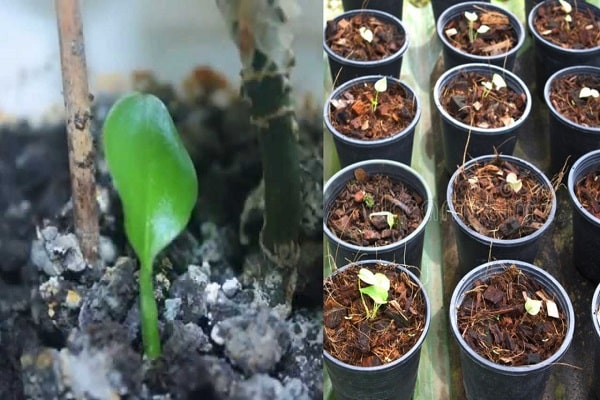
Seeds are not a very common way to grow an Aglaonema, and not many gardeners choose to do it. And another reason is that using cuttings or dividing plants is so easy, quick, and safe that it seems silly to use seeds.
- First, you must ensure your plant has what it needs to bloom and make seeds. If you live in a place where it doesn’t get very hot, your plants may never bloom. Once the plant blooms, wait until the berries are fully ripe before taking the seeds.
- To grow more Aglaonema, you need to use fresh seeds. You can find fresh seeds at the base of your fully grown Aglaonema flowers. Ensure you wash your seeds in acidic water before doing anything else.
- Once you have the seeds, fill a pot with a good potting mix and substrate. Then, bury the seeds, but not too deep, so that they can grow. Give the pot a lot of water and put it where it will get direct sunlight.
- Water the soil when you notice that the top layer is becoming parched. There is nothing else to do but wait. This process moves fairly slowly. Seeds may need between one and a half and two months to grow. You need to be able to wait.
- Remember that if you want to grow Aglaonemas from seeds, you must use a coco-peat mix or a seed germination soil mix. The next step is to spread the fresh seeds over the mixture and then lightly cover them. For the best results, put the container where the seeds can get indirect light and room temperature.
- A seed’s time to sprout might range from 45 to 60 days.
Propagation Of Aglaonema Using Root Cuttings
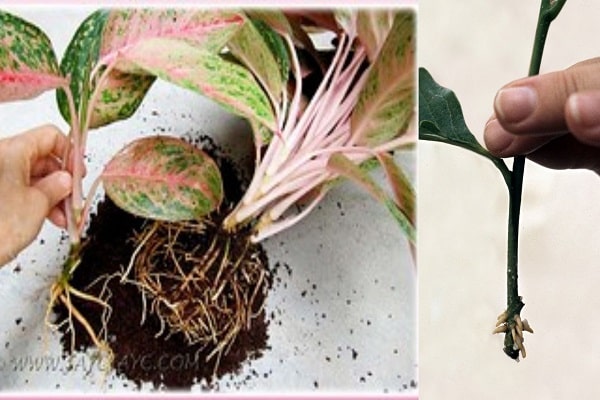
Take cuttings from the roots of your Aglaonema plants to make more of them. It’s the greatest approach to ensure your garden thrives, but it could be challenging for first-timers. But it’s not that hard if you’re careful. Most people who like plants agree that the safest way to spread Aglaonemas is by taking root cuttings. But starting may find this method hard because it requires more care. Easily scared people shouldn’t use this method.
- In this method, the roots of a plant are cut off from the mother plant and planted in a new pot. You must keep new plants in light that doesn’t hit them directly.
- Using this method, you take the mother plant with its roots and put it in a separate pot. The new plant is put in the new pot and kept where it can get indirect sunlight. The new plant will quickly grow its roots in 5 to 10 days.
- You should put your new plant somewhere a little warmer. Aglaonemas grown from root cuttings are much like stems because they won’t do well in cold areas.
Propagation Of Aglaonema In Water
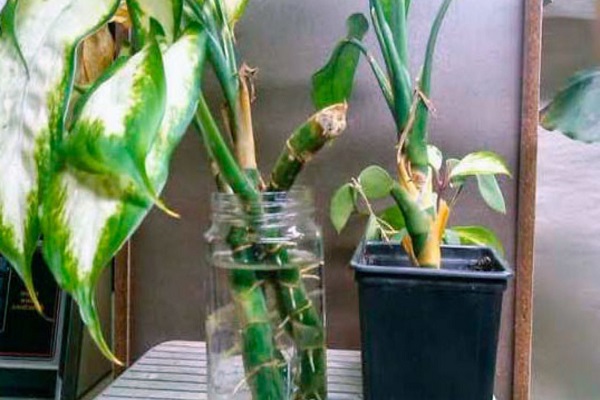
Water propagation is the best approach for Aglaonema. This approach requires a period in water for roots to develop without dirt or pebbles.
This procedure takes a few weeks before planting, so be prepared to cut aglaonema stems in water. They glow in natural light, which they’ll require.
- This procedure needs materials. Rooting hormone, room-temp water, clear jar. Now, clean. Aglaonema is diseased. Preclean tools and containers.
- Find out which plant stems aren’t needed before you cut them. If so, make the stems even. Marks are made on cut stems with twine or knots. Pick the stems you want before you cut. Move on once you have learned how to balance the stems.
- Find the nodes on the stem first. The nodes are where the leaves branch off. Just below the bulge of the stem, make clean cuts to let the leaves separately. See the picture to see where and how to cut. When in doubt, cut as close as you can to the stem.
- This keeps clippings safe. Plant growth is slowed by temperature, humidity, sunlight, and water changes. This helps plants grow roots when times are hard. Stems are dipped 1 cm into powder. There isn’t the best way. Some will fall off, which is fine. Just dust the stem cuts with powder.
- Wait a minute after putting the cuttings in the rooting hormone powder. This gives them time to soak up as much of it as possible before it goes away. Put each slice of bread in the water. Be careful so that the rooting powder doesn’t come off too quickly. Some of the powder can float.
- Change the water in your root vases every few days. Roots vases. By doing this, you avoid allowing germs or fungi to take root near your cuttings. Hazardous tap mineral accumulation is removed. Use distilled or spring water in bottles if your tap water is hard.
Propagation Of Aglaonema Using Of Tissue Culture
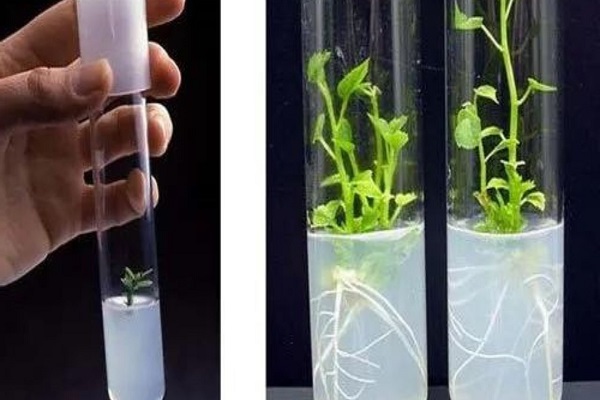
This is the best way to grow a lot of Aglaonema seedlings in a short amount of time. Because of this, tissue culture is often used to grow these plants in large quantities and for business purposes. This method uses a small piece of the original plant’s leaves, stem, or root to grow new seedlings.
This method of spreading won’t work because it requires tissue culture, which you can only do in a lab. The seedlings are slowly exposed to the weather conditions they will face in the wild. Even though tissue culture is a slower way for your Aglaonemas to grow, it is still the best way to make many of them.
This method uses a small piece of the original plant, like its roots, stems, or leaves, to grow new seedlings. For this method to work, the new seedlings and tissue culture must be in a place that looks like a lab. Later, seedlings are slowly exposed to the weather outside. In this process, plants tend to grow slowly, but it is still the best way to make many strong plants. But you won’t use this type of reproduction at home.
The Best Time To Propagate Aglaonema Plant
Just now, I went over every Chinese evergreen propagation strategy. Still, I didn’t mention at any point when you should use each one. You may be doing a grave error by trying to propagate your Aglaonema during the depths of winter.
The middle of summer is the ideal period to multiply this houseplant via cuttings or seeds. This is because this is the time of day when the temperature is at its highest. On the other hand, this is certainly something that is completely intertwined with the climate in which you reside.
You won’t have to hold out for summer if you are lucky enough to call a tropical region home. You can start new plants from your Aglaonema cuttings at any point during the year. But if your winters are usually cold, you should wait until the summer or at least until the spring.
The Benefits About The Aglaonema Plant
An aglaonema is a great option if you’re looking for a low-maintenance, beautiful houseplant. Here are a few benefits of this plant:
- The Aglaonema is easy to care for and doesn’t require a lot of attention.
- It’s a beautiful plant that can add style and elegance to any room.
- The Aglaonema is known to be an excellent air purifier, helping to remove toxins from the air.
- This plant is also known to help improve indoor humidity levels, making it ideal for dryer climates.
- The Aglaonema is a resilient plant that withstands neglect and poor growing conditions.
- Aglaonema is a great choice for people with allergies, as it’s not associated with any known allergens.
- The Aglaonema is a great choice for people who have trouble getting plants to grow. If you’re interested in growing this plant, be sure to get some information on how to do so successfully.
Frequently Asked Questions
How Do You Make Aglaonema Grow Faster?
To make Aglaonema grow faster, you must provide it with the correct conditions. It should be in a well-lit spot, out of direct sunlight. The temperature should be warm, between 65-85 degrees Fahrenheit. The soil should be kept moist but not too wet. Fertilize every two weeks using a balanced fertilizer.
Why Do Aglaonema Leaves Droop?
The leaves of the Aglaonema plant are known to droop for various reasons.
- One reason could be that the plant is not receiving enough water. The leaves will droop if the soil is too dry to conserve water.
- Another reason could be that the plant is not receiving enough light. If the leaves do not get enough light, they will also begin drooping.
- Finally, the temperature could be too cold for the plant.
Does Aglaonema Like To Be Root Bound?
Aglaonema, or Chinese evergreen, is a hardy houseplant that can tolerate low light and irregular watering. Though it is tolerant of being root bound, it is best to report Aglaonema every two to three years to ensure optimal growth. Aglaonema prefers well-draining, slightly acidic soil and should be watered when the top inch of soil is dry.
What Is The Best Fertilizer For Aglaonema?
When choosing the best fertilizer for Aglaonema, there are many things to consider. What kind of fertilizer you use depends on what the plant needs and how it is growing. Fish emulsion, worm castings, and compost are all common ways to feed Aglaonema. When choosing a fertilizer, you should also consider what nutrients the plant needs and what soil it is in.
During the spring and summer, feed your Aglaonema once a month with a general-purpose houseplant fertilizer that has been diluted by half, like our All Purpose Fertilizer (20-20-20). During the winter, fertilizer is not needed when growth slows down. This plant is somewhat dangerous to both people and animals.
How Do I Make My Aglaonema Bushy?
You can do a few things to make your Aglaonema bushier.
- First, you can prune the plant to encourage new growth.
- Second, you can fertilize the plant to promote fuller growth.
- Third, you can provide the plant with adequate light and water to encourage healthy growth.
By doing these things, you should be able to make your Aglaonema plant fuller and bushier.
Final Thought
Aglaonema propagation is an essential aspect of the growth and maintenance of these beautiful, tropical houseplants. With a variety of methods, including stem cuttings, division, and air layering, gardeners can easily propagate Aglaonema plants to expand their collection or share with fellow plant enthusiasts.
These techniques not only contribute to the plant’s overall health but also help to preserve the genetic diversity of the species. By understanding the specific requirements for each propagation method, such as optimal temperature, humidity, and lighting conditions, individuals can successfully propagate Aglaonema and enjoy their vibrant foliage for years to come.

My name is Md Robiul Islam and I’m a plant enthusiast. I like to have a garden and research different plants. I also have an interest in environmental science and would like to work in that field in the future.


